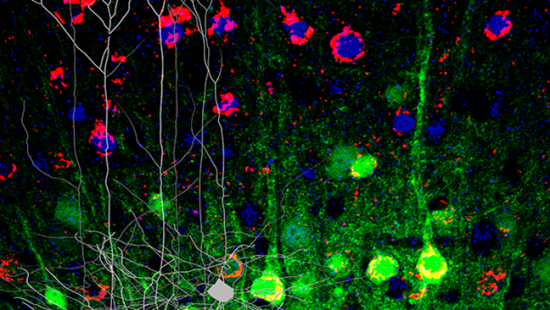
Neurons are a bit like people: though they share some common features, they can vary greatly in appearance and function. Proteins called transcription factors determine how neurons look and act by turning genes in the cells on and off.
In the picture above, scientists labeled a transcription factor called Fezf2 (in green) in cells in the motor area of the mature mouse cortex. Neurons in the layer above (in red and blue) did not express Fezf2. The grey cells show how neurons change shape after Fezf2 is expressed, growing highly complex extensions called dendrites.
Dendrites and axons transport electrical and chemical messages in and out of a nerve cell, enabling neurons to communicate with one another with incredible speed and precision.
The intricate branches, or arbors, of these extensions are what give neurons their beautifully strange and varied shapes. Dendrite arbors, for example, make some neurons look like sea coral, others like spider webs, and still others like round balls of tumbleweed. Axonal arbors are equally diverse. They can have a simple T shape and be quite short (less than one inch). Or they can be multi-branched and stretch, as do the axons of the sciatic nerve that run along the back of the thigh, for as long as three feet.
By studying the structural diversity of neurons, scientists are gaining greater insight into how the brain and the rest of the nervous system works.
Reference:
Tantirigama ML, et al. Expression of the developmental transcription factor Fezf2 identifies a distinct subpopulation of layer 5 intratelencephalic-projection neurons in mature mouse motor cortex. The Journal of Neuroscience. 2014 34(12):4303-8.
